Automatons

An automaton is a mechanical device designed to look and move like a human being. It is true that such devices have been made for over 2500 years. Here I will list links to sites that show some of the earliest, cleverest or just down right beautiful..
Jean Henri Nicholas Maillardet (1745–1830)
Having spent time with Jaquet-Droz in London Henri and his brothers, Jaques-Rodolphe and Jean David, started making an automaton.
The Draughtsman-Writer (1805)
Lost for many years it was given to the Franklin Institute, Philadelphia USA, by decendants of John PennBrock. It having been partially destroyed by a fire they restored it and discovered that it can draw seven accurate sketches and writes three poems in the most perfect handwriting. And it signs off with the maker’s name !
Short medium resolution video by The Metropolitan Museum NY (1m36):
Longer video showing all of its features but frustratingly low resolution (38m45):
A little bit more about how the machine works is here (text):
Due to the fire the original writing instrument had been lost therefore Francis Blanche spent 8 years trying to work out how the pen can deliver varying widths of cursive writing so perfectly copying a human scribe: Fran Lab: Solving The Mystery Of The Maillardet Automaton
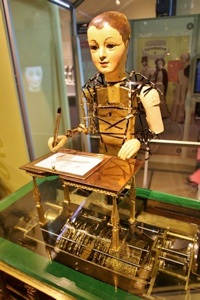
Pierre Jaquet-Droz (1721–1790)
Clockmaker Pierre Jacket-Droz (born in Neuchâtel Prussia now Switzerland), and his brother Henri-Louis, made complex clocks and mechanical song birds. Between 1768 and 1764 they turned their hand to automata in order to advertise their clockmaking prowess. Three became very famous The Draughtsman, The Musician and The Writer. For a treatise on his whole life see (17m49): Jaquet Droz Corporate Movie
A Swiss website has been set up sell complex modern timepieces. Detailed history is given here: Jaquet-Droz.com (somehow this website can be jolted into English)

Ancient Automata
Depending on your definition of an automaton you may consider a number of devices to be the earliest. Obviously the Chinese made various ones that we know very little about . However I do remember being told about The Maidservant whose right arm poured wine when a container was placed on her left hand made by Philo Of Byzantium in 250BC. It is featured from 11m50 here (21m29): Kings & Things: Proto-Robots of Antiquity
Gaston Decamps (lifespan unknown)
Unrestored Talking Boy (1910)
His other well known creation is as yet unrestored. Most of the clockwork is missing but it evidently drove the arms and belows that operate his eyelids and lower lip. Height 760mm
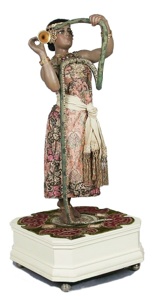
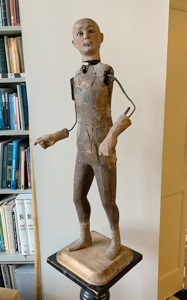

La Charmeuse de Serpent (1907)
Zuma The Snake Charmer was his first creation. The clockwork woman’s arms, body and legs dance and the snake head wriggles to four tunes. Gilt metal and velvet carpet in green and red embroidered in metal yarn. Height 920mm
Decamps & Roullet & Durand
Various collaborations of these three produced many beautiful musical automatons.
Professor Arcadius (1937)
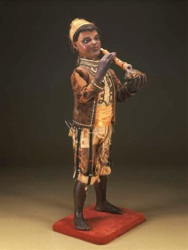
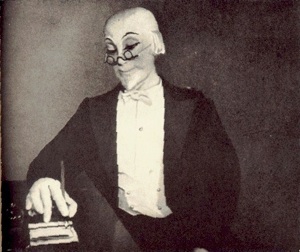
Black Tortoise Charmer
Professor And The Dunce
(1895)

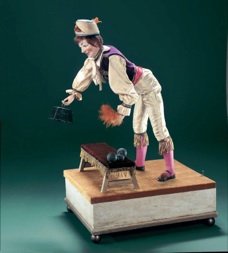
HerculesTheWeightLifter(1900)
Jacques de Vaucanson (1709-1782)
Most early automatons were built to study the movement of animals. Vaucanson’s Duck (1738) is a good example of this. He was a very early user of cams to control the progress of movement during the operation of the mechanism.
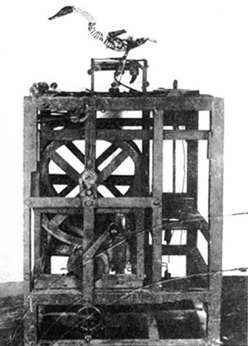
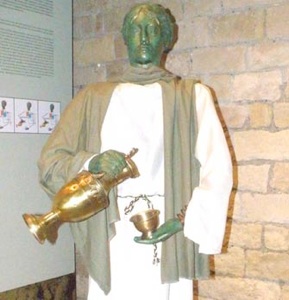



The Duck (1738)
..To Be Expanded
The Writer (1772)
Made of 6000 components this most ingenious machine took 4 years to complete. The Writer is completely programmable -able to write any sentence up to 40 characters long. Coded tabs are placed on a large wheel at the rear. Hand movements, in three dimensions, direct a goose feather to write. Ink is picked up frequently including a tap of the wrist to remove excess. The eyes follow the feather movement and his head turns when recharging ink. Height 700mm.
See: BBC: Mechanical Marvels-Clockwork Dreams with Prof Simon Schaffer
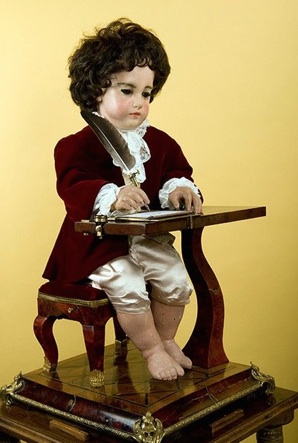



The Daughtsman (1774)
It took Jaquet-Droz and Jean Frédéric Leschot two years to build its 2000 components. Using a lead pencil it can draw:
1) Portrait Of Louis XVI
2) Marie Antoinette
3) A Dog
4) Cupid Riding a Chariot Pulled By A Butterfly.
There is a bellows that enables it to periodically blow small shards of pencil away from the writing paper !
Height: unknown.
Restoration
As they were bought and sold each of the automatons had been lost at times. They were eventually brought together at the Musée d'Art et d'Histoire de Neuchâtel and carefully restored. Here is a superb insight into that process and thereby how each one brilliantly works (18m13 all in French): Restauration des automates de Pierre et Henri Louis Jaquet Droz
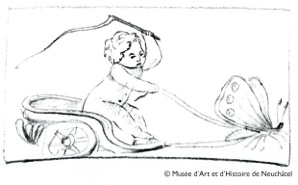
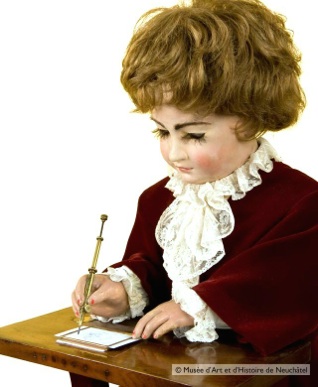
The Musician (1774)
Concurrently with his brother’s work above Henri-Louis Jaquet-Droz also took only two years to build this remarkably complex instrument of 2500 precision components.
As he was a musician it’s thought that he composed all five original songs that the woman plays on a genuine custom-built organ using her fingers on the keys.
Three clockwork motors provide the organs air, the arm, hand and finger movement (all 10 are separately controlled) and the peripheral movements of the body. You see her head and eyes following what she plays and remarkably her leaning into the instrument as she plays along with her breathing. She plays for over an hour curtsying between each tune !
The. height a very large 1500mm.
See (0m26): Jaquet Droz Automaton The Musician



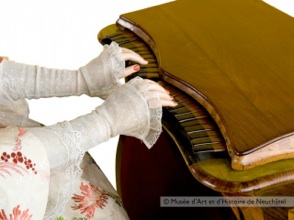

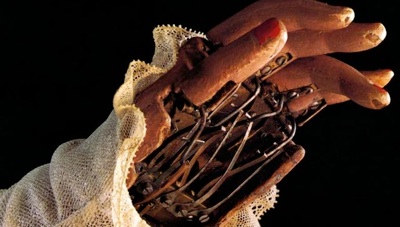


Automaton Museums Worldwide
See separate webpage: Automaton Museums
For some reason Vaucanson seemed to have an obsession with ducks so in 1738 he brought the phrase duck movement to a whole new meaning because this one would scoop water, peck and eat grain and then defecate it !
Of course it was all a con but nonetheless it appeared to do what he claimed. See the surprising list of facts here: Wiki

Digesting Duck (1739)
If you are really interested it is worth looking up his lifesized jeweled gold walking Ethiopian Caterpillar. He also made a Siberian Mouse and Egyptian Lizard -Forbes and Christies are good sources of information. He made only one other Automaton that could write; it wrote in Chinese and was made for the Emperor of China as a gift from King George III of England.
Japanese Karakuri
The Japanese Archer (1860) picks up arrows and fires them over a distance of 3-4m (four per wind of the clockwork). He is accompanied by two women -one waves and one rings a bell.
It used to be kept at the York automaton museum (closed since mid-1990s).

Leonardo Da Vinci (1452-1519)
No discussion of inventions can omit Leonardo. As usual he contributed considerably to the subjects that he studied.
Robot Knight
As well as a plane, helicopter, tank and other war machines Leonardo devised a robot in human form for the Duke Of Milan, Ludovico Sforza, in 1495. Only his sketch drawing survive so a best guess was built by Mario Taddei in Italy in 2007. It replicates human movements well.
Scroll down here for some footage but his commentary, understandably, is in Italian: Leonardo’s Robot Knight


Other Leonardo Information
For other inventions see Channel4’s excellent programme Leonardo's Dream Machines
I’ve had this foldout book and studied it for a long time. I’ve never seen an Amazon product with 100% 5* but this has: The World Of Leonardo Da Vinci by M Landrus
To encourage children with enquiring minds see this brilliant pop up book: Leonardo da Vinci Incredible Machines
In 1515, not long before he died, Leonardo made a plaything for the King Of France -a mechanical robot lion.
From his drawings again guesses have been made as to how it might have looked.
There is a commercial model of how it might have worked: Leonardo Da Vinci’s Mechanical Lion by Italeri
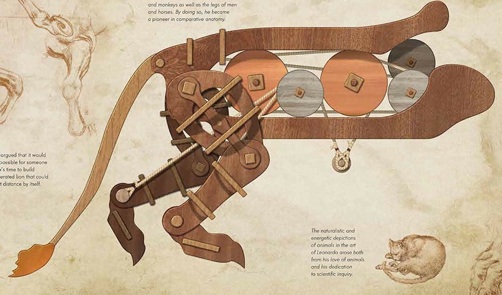
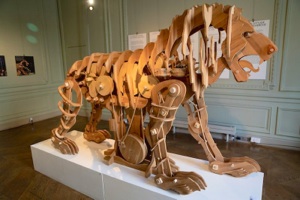
Robot Lion
A new page has been produced. Please follow this shortcut:

Disclaimer
Whilst some care has been taken to check externally linked websites no responsibility is offered nor implied for the suitability, legality or reliability of content therein.

